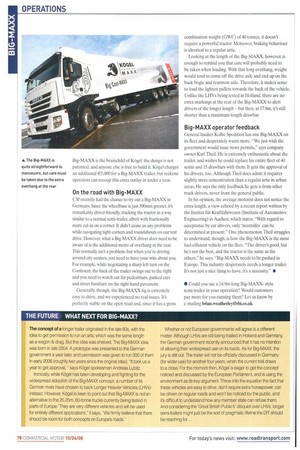Take it to the MAXX!
Page 76

Page 77

Page 78

If you've noticed an error in this article please click here to report it so we can fix it.
While the UK's Department for Transport continues to shilly-shally over LHVs, Germany has grasped the nettle of longer trucks with the Big-MAXX semi-trailer. Is this the acceptable face of bigger lorries?
Words / Images: Will Shiers Consider if you will 'Longer Heavier Vehicles', and, in particular, how the Department for Transport (DIT) has obfuscated and delayed its decision to allow trials of 25.25m-long rigs on our roads.
At the time of writing, the long-awaited (and, more importantly, long overdue) official joint report into LHVs by Transport Research Laboratory (TRL) and Professor lain Mackinnon of Heriot-Watt University is still sitting on a desk somewhere in Marsham Street, no doubt with ministers hoping it will just go away. It won't. Ever since the DfT started its dialogue with the likes of Dick Denby, it's been slowly but surely painting itself into a corner on LHVs. It's time to step on the paint.
By way of contrast, two years ago, German authorities gave the go-ahead for operator trials of 300 14.9m-long semi-trailers with conventional artics to see it among other things, they were "traffic compatible" on German roads.
Clearly, a 17.8m-long artic is far less controversial than a 25.25m-long roadtrain, But the DfT's current agonising over LHVs hardly promotes the image of a go-ahead government department keen to explore every possible avenue in terms of boosting road freight efficiency.
Kogel's Big-MAXX extra-long trailer was officially launched at the Transport Logistic Trade Fair in June 2005 in Munich. With an additional 1,30m, it can carry 36 pallets compared with the normal 33 euro-pallets, According to a survey carried out by the German firm Kessel & Partner, heavy trucks work at up to 85% of full capacity (volume), so a longer semi-trailer concept could help reduce traffic congestion by up to 8% where operators are running out of load volume on a single artic.
Kogel, meanwhile, has its own impressive statistic in favour of longer semi-trailers. It reckons that one in every eight artics could be taken off Europe's roads if its BigMAXX semi-trailer received widespread acceptance in European Union member states. Not surprisingly, Germany was the first country to dip its toe into the water on longer trailers — it's already some two-and-half years into a comprehensive six-year trial, and when the original total of 300 permits were issued, they were quickly snapped up by 50 hauliers.
Germany isn't the only EU country to give Big-MAXX trailers a go. Late last year, the Czech Republic went a step further, announcing that its domestic hauliers could run an unlimited number of the vehicles on any of its roads. Industry rumours suggest a neighbouring country, Poland, is also about to approve it, and Kdgel is optimistic more will follow suit. Apparently, Iveco and the Italian Automotive Association have also approached the Italian government, who are said to have "a positive attitude on the project". They reckon a trial involving a couple of hundred examples is imminent. "There is absolutely no reason why this concept can't be rolled out across the whole of Europe, including the UK," a KOgel spokesman says.
Potential markets The 14.9m-long Big-MAXX has a rear overhang 1m greater than a standard semi, while the wheelbase has been extended by 300mm, which gives an additional 8% to 10% load capacity within the longer 17.8m overall vehicle length. However, for the moment, the overall permissible GCW of these longer artics remains at the normal European 40-tonne limit — or at least it has done in Germany and the Czech Republic. So naturally, the benefit of a Big-MAXX will be with the hauliers who cube out, rather than weigh out.
Of the 300 trailers on Germany's roads, the vast majority are curtainsiders. However, Kogel has identified a number of other potential markets, including flatbeds, box vans and swap-bodies. Were this concept ever to make it to the UK, then double-deckers would be the obvious choice of body style for many. The Big-MAXX also has potential as a reefer, especially since the transport pressure group Transfrigoroute has been campaigning for years for larger refrigerated trailers on safety grounds.
The company says cold air is often unable to circulate around pallets in a regular 13.6m trailer, resulting in some products failing to drop to the required temperature. But is this the right solution? After all, won't the majority of operators simply squeeze in an extra three pallets, taking them back to square one?
Either way, the first BigCool-MAXX has been given to the Transfrigoroutc president to test. Although Big-MAXX is the brainchild of Kiigel, the design is not patented, and anyone else is free to build it. Kogel charges an additional €5,000 for a Big-MAXX trailer, but reckons operators can recoup this extra outlay in under a year.
On the road with Big-MAXX
CM recently had the chance to try out a Big-MA)0C in Germany. Since the wheelbase is just 300mm greater, it remarkably driver-friendly, tracking the tractor in a way similar to a normal semi-trailer, albeit with fractionally more cut-in on a corner. It didn't cause us any problems while navigating tight corners and roundabouts on our test drive. However, what a Big-MAXX driver does need to be aware of is the additional metre of overhang at the rear. This normally isn't a problem, but when you're driving around city centres, you need to have your wits about you. For example, while negotiating a sharp left turn on the Continent, the back of the trailer swings out to the right and you need to watch out for pedestrians, parked cars and street furniture on the right-hand pavement.
Generally, though. the Big-MAXX rig is extremely easy to drive, and we experienced no real issues. It's perfectly stable on the open road and, since it has a gross combination weight (GWC) of 40 tonnes, it doesn't require a powerful tractor. Moreover, braking behaviour is identical to a regular artic.
Looking at the length of the Big-MAXX, however, is enough to remind you that care will probably need to be taken when loading. With that long overhang, weight would tend to come off the drive axle and end up on the back bogie and rearmost axle. Therefore, it makes sense to load the lightest pallets towards the back of the vehicle. Unlike the LHVs being tested in Holland, there are no extra markings at the rear of the Big-MAXX to alert drivers of the longer length — but then, at 17.8m, it's still shorter than a maximum-length drawbar.
Big-MAXX operator feedback
General haulier Kolbe Spedition has one Big-MAXX on its fleet and desperately wants more. "We just wish the government would issue more permits," says company owner Karl Theil. He is extremely enthusiastic about the trailer, and wishes he could replace his entire fleet of 40 semis and 15 drawbars with them. It gets the approval of his drivers, too. Although Theil does admit it requires slightly more concentration than a regular artic in urban areas. He says the only feedback he gets is from other truck drivers, never from the general public.
In his opinion, the average motorist does not notice the extra length, a view echoed by a recent report written by the Institut ftir Kraftfahrwesen (Institute of Automotive Engineering) in Aachen, which states: "With regard to acceptance by car drivers, only 'neutrality' can be determined at present." One phenomenon Theil struggles to understand, though, is how the Big-MAXX is the most fuel-efficient vehicle on the fleet. "The driver's good, but he's not the best, and the tractor is the same as the others," he says. "Big-MAXX needs to be pushed in Europe. This industry desperately needs a longer trailer. It's not just a nice thing to have, it's a necessity." III • Could you use a 14.9m-long Big-MAXXstyle semi-trailer in your operation? Would customers pay more for you running them? Let us know by e-mailing brian.weatherley@rbixo.uk












































































































































































































